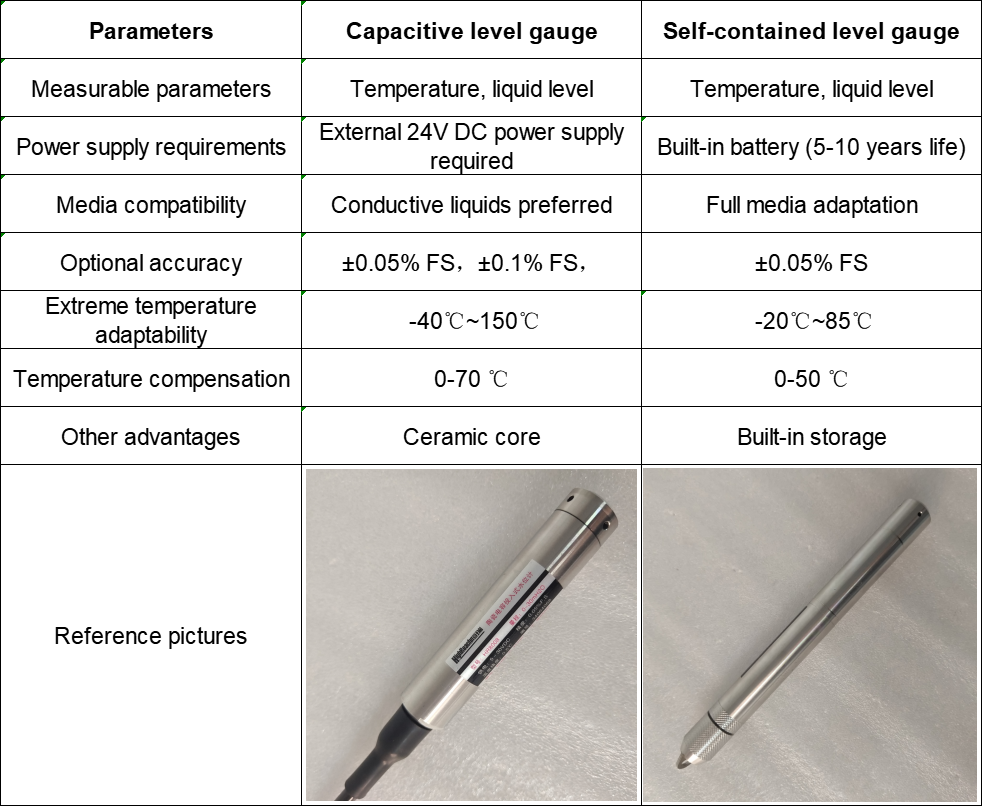Solutions-Flow Transmitter
Capacitive Level Gauges vs. Self-Powered Level Gauges
Capacitive Level Gauges vs. Self-Powered Level Gauges:
Core Differences and Application Scenario Analysis
In the field of industrial automation, the precision requirements for level measurement are increasing day by day. Capacitive level gauges and self-powered level gauges, as two mainstream technical solutions, are often confused due to their similar names.
In fact, there are significant differences in their design principles, application scenarios, and technical advantages. This article will provide an in-depth analysis of the core distinctions and potential connections between these two types of level gauges, from working principles and technical characteristics to industry applications, offering clear guidance for engineering selection.
1. Principle Differences: The Underlying Logic of Capacitance Effect and Self-Powering
Capacitive level gauges detect liquid levels based on the principle of capacitance change. Their core structure consists of inner and outer electrodes. When the measured liquid contacts the electrodes, changes in liquid level result in alterations in capacitance, which can be converted into a level signal through circuitry. These devices are highly compatible with conductive media (such as water, acidic, and alkaline liquids), but insulating sleeves are required for non-conductive liquids (such as oils) to enhance detection sensitivity.
Self-powered level gauges, on the other hand, adopt an integrated design with built-in power supplies and signal processing modules. Their most notable feature is the ability to operate independently without external power, relying on internal batteries or energy harvesting devices (such as vibration-powered generators) to sustain operation. This design makes them excel in field or mobile equipment without external power sources, such as tank truck level monitoring or remote storage tank surveillance.
2. Technical Comparison: Structural Complexity and Application Scenarios
Structural Design and Installation Cost
Capacitive level gauges typically employ a split-type structure, with the electrodes and transmitter installed separately, suitable for scenarios requiring long-distance signal transmission (such as large storage tanks). However, the split design may increase wiring costs and is more susceptible to electromagnetic interference.
Self-powered level gauges are characterized by their compact, integrated design, with the sensor and data processing unit integrated into the same housing, facilitating easy installation and stronger anti-interference capabilities. For example, in corrosive environments in chemical plants, their enclosed structure can effectively resist gas erosion.
Comparison of Media Adaptability
Capacitive Level Gauges:
Advantages: Suitable for liquids with a conductivity of ≥20μS/cm, such as industrial wastewater and acid/alkali solutions.
Limitations: Prone to wall-clinging errors with viscous media (such as asphalt), requiring regular electrode cleaning.
Self-Powered Level Gauges:
Advantages: Through the integration of multiple technologies such as piezoelectric and ultrasonic, they can cover both conductive and non-conductive liquids (such as crude oil and liquefied gas).
Limitations: High-frequency signal processing may be affected by temperature fluctuations, necessitating additional temperature compensation modules.
3. Technological Evolution: Cross-Fusion and Innovative Breakthroughs
Despite the competitive relationship between the two types of level gauges, recent technological developments have shown a trend of complementary functions. For example:
Some capacitive level gauges incorporate low-power designs, paired with solar cells to achieve a "quasi-self-powered" operating mode.
Self-powered level gauges integrate capacitive detection modules, expanding their measurement accuracy for conductive media.
This technological fusion is particularly prominent in the smart water management sector: capacitive sensors are responsible for high-precision water level monitoring, while self-powered devices enable data transmission via wireless means, constructing a complete IoT monitoring network.
4. Selection Decision: Key Parameters and Cost-Benefit Analysis

Lifecycle Cost
Capacitive Level Gauges: Lower initial procurement costs, but wiring and maintenance expenses need to be considered.
Self-Powered Level Gauges: Higher unit prices, but save on installation and operation and maintenance investments, suitable for scenarios where wiring is difficult.
5. Industry Application Map
l Petrochemical Industry:
Capacitive level gauges are used for acid/alkali level monitoring in reaction vessels, while self-powered level gauges are used for wireless monitoring of underground oil storage tanks.
l Food and Pharmaceutical Industry:
Capacitive level gauges detect fermentation tank levels, while self-powered level gauges track liquid raw materials in cold chain transportation.
l Environmental Protection and Energy:
Self-powered level gauges dominate reservoir water level monitoring, while capacitive level gauges are used in wastewater treatment process control.
Through the above comparison, it is evident that capacitive level gauges occupy the existing market with their cost-effectiveness and mature technology, while self-powered level gauges are opening up new application areas with their wireless and low-power characteristics. In engineering practice, the most suitable technical route should be selected based on media characteristics, environmental conditions, and long-term operation and maintenance requirements.
RELATED NEWS
- Technical Introduction of Reverse Flushing Flow Meter 2025-06-12
- Liquid Level Switch, Level Meter And Liquid Level Transmitter 2025-05-22
- Troubleshooting Methods for Electromagnetic Flowmeters 2025-04-28
- Understanding the Basics of Groundwater Quality Monitoring Data 2025-04-15
- Customer Case Study:Chained Temperature Transmitters 2025-03-18
CATEGORIES
LATEST NEWS
CONTACT US
Contact:Roxy Deng
Phone:+8617794001501
Tel:+8617794001501
Email:roxy@besteetech.com
Add:Weibin District, Baoji, Shaanxi Province, China
 Roxy Deng
Roxy Deng Roxy Deng
Roxy Deng